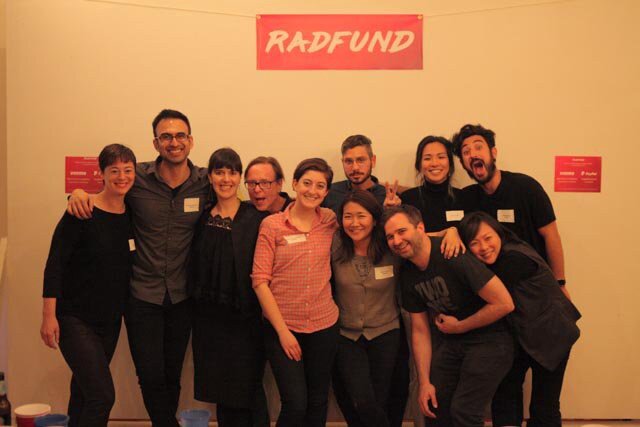Guide to Giving Circles: Pooling resources to support change and build community 🤲 Joelle Berman and LiJia Gong
Listen on: Apple, Google, Spotify, Stitcher, TuneIn, Overcast, Pocketcast, RSS
Read: Transcript
Episode at a glance:
GUEST: LiJia Gong and Joelle Berman
COMMUNITY: Giving Circles
HOSTS: Bailey Richardson & Kevin Huynh
“This is about everyday people coming together with their friends, with their families, with their community, with their colleagues and saying that they have a voice and that they want to use it in a constructive and powerful way in their communities. It just happens to be that we're dealing in philanthropy.” - Joelle Berman
Show Notes
In this episode, we sit down with two bad**s women for a conversation on the joy and challenges of giving circles–how to get one started, how to reach a consensus as a group, and how to celebrate along the way.
What is a giving circle?
For those of us sitting with the responsibility of long-term, sustained antiracist action (🙋), the giving circle is a great way to start structuring those efforts.
Giving circles are simple: People gather in groups to pool their money and then decide where it goes. Most circles have a guiding cause that members collectively care about–for example, the African American Women’s Giving Circle or the Funding Queerly Giving Circle.
Giving circles invert the traditional philanthropic model, wherein a rich person and their team determine where huge sums of money go. Instead, giving circles empower everyday people to do the research, make collective decisions, and direct their funds towards the changes they care about.
As a bonus, these circles often become little communities — political homes even–for their members.
In 2015, LiJia Gong attended marches and supported the #BlackLivesMatter movement. She felt inspired to do more. So she and three friends started gathering, exploring how they might use the bonds of their friendship and shared values to reduce inequality. Their giving circle "Radfund" was born from these conversations. The friends pledged to pool 1% of their annual income and 0.1% of their wealth annually to support organizers in NYC doing the work to challenge structural inequality and fight for racial and economic justice. In this episode, LiJia will share stories and insights she’s learned from building a "political home" for herself and her friends.
Joelle Berman was recently the founding Executive Director of Amplifier, a global network of 125+ giving circles inspired by Jewish values. From that position supporting so many different giving circles, she had a rare view of the ecosystem as a whole, and was able to pinpoint trends and best practices. (Shout out to Amplifier's founder, Felicia Herman, and Amplifier's current CEO, Liz Fisher, for their work continuing to spread the power of collective giving!)
While you’re listening to LiJia & Joelle, keep an ear out for some of our favorite insights:
First step is to agree: “what do we want to put out into the world?”
One of the earliest steps for any giving circle is determining the group’s purpose. For LiJia, this meant having deep conversations about WHO: which organizers do they each admire, and what traits do they have in common? Radfund’s mission backs out from those insights. Joelle recommends a different process, asking questions like, “How had group members been giving before? How do they want to give? What purpose do they see this group serving?” These questions pull out group values so that they can back into a mission based on real world examples.
Joyful giving and celebration is essential.
A giving circle’s value to members is as much about the relationships they build together as it is about giving. There should be food, drinks, and dancing (if the mood is right) to celebrate what you’re learning, the cause you’re giving to, and the impact you’re making. The more fun you have together, the more you’re likely to keep giving together.
From the first ever #Radparty with Radfund.
Lean into the grassroots identity.
These giving circles are not professional, polished mega-philanthropies. They are the opposite: grassroots, local, soulful. LiJia and Joelle encourage giving circles to reflect that character in the details of how they operate. For example, consider hand-writing and mailing checks to organizations instead of digital transfers. These small decisions bring intimacy to giving, an antidote to the anonymity of other philanthropy.
Bonus: Popcorn Q&A with LiJia and Joelle
As a supplement to our podcast interview, we hosted an AMA-style conversation with LiJia and Joelle on our Substack to learn more about giving circles.
Below you will find a few highlights. You can read the full thread here.
Do you have advice on how to initiate the conversation with friends and family to start a giving circle?
LiJia: I would start with meeting folks where they are, and asking about what social issues they feel passionate about (whether in their neighborhood, city, state, country, or the world) contributing to and letting the conversation go from there.
I think the conversation is probably also different based on whether folks have a practice of giving. For folks who do have a preexisting practice of giving, I think it’s worth asking about how they give and what causes they give to.
(Of course, this is somewhat specific to Radfund, since we’re a giving circle that focuses on economic justice and racial justice.)
Joelle: It’s this simple: just start by asking,
“Do you ever feel like your donations actually make a difference?”
Usually people say “No, not really.”
It provides an opening to a new conversation about how much more powerful and transformative it would be to pool a much larger amount of funds (or time, or other kind of asset) than you could have ever given on your own, and make a bigger impact together.
People usually follow that up with: “OK, but what’s the commitment like?” And then you can say, “It’s up to us! We can figure it out together so that it’s manageable for all of us.”
What are your biggest lessons learned — what NOT to do?
LiJia: One lesson I’ve taken away is that it’s been really helpful for our group to keep things concrete for our discussion — instead of whether we should expand in the abstract, do we want to invite *this person* into the group. We are all a bunch of heady, opinionated people, so the abstract conversations could go on for hours without really getting anywhere. And another lesson is keeping it fun!
Making sure we all center joy, connecting with each other and deepening our relationships.
Joelle: Don’t feel like you need to have it all figured it out before you begin! You will figure it out as you go.
AND: Don’t be afraid to talk about money and how much — sometimes, we underestimate how much people are willing to give to something that’s meaningful to them. Asking folks for a “meaningful gift” rather than, say, $50 or $100 will almost always result in a larger contribution than you expected.
How do you balance being proactive, giving to organizations that you do deep research on and spend time learning about, and reactive, giving to organizations based on need in the current moment?
LiJia: Such a good, and hard, question! At Radfund, we do most of our giving once a year, and there’s a process where we nominate groups, ask organizers and folks we trust to recommend groups, and have deep (and long) conversations about what groups to give to.
With that said, we do have a rapid response process for giving that is more based on need in the current moment. For example, because of COVID-19 and, particularly, its economic impact on immigrants and communities of color, we decided to do rapid response giving — some to the groups we have previously given to and some to new groups that were meeting the moment — for example Housing Justice for All, which has been organizing around eviction moratoriums and rent cancellation.
Joelle: My friends and I are actually in a giving circle, and this is something we always try to keep in balance. What we often did was honor our proactive process of researching and giving the majority of our pooled funds to the organizations we had spent time learning about; we would also then usually commit about 25% of our pooled funds to something timely that was happening in the world, and that needed our attention.
I should note: the “timely” donations were rarely disaster-focused; instead, they reflected the values and principles that guided all of our giving, and helped us address something more timely (usually having to do with an election, piece of legislation, or supporting a community that faced an imminent threat).
Read the full thread here.
Get Together is produced by the team at People & Company.
We published a book and we’ve worked with organizations like Nike, Porsche, Substack and Surfrider as strategy partners, bringing confidence to how they’re building communities.
Stay up to date on all things Get Together.



